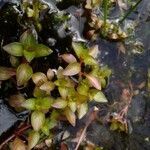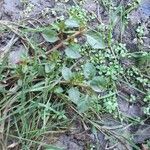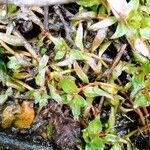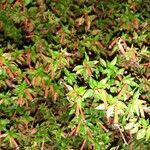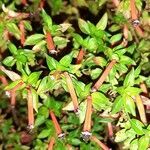Procumbent or ascending herb with branched floating glabrous stems to 50 cm long, rooting freely at nodes. Leaves opposite, broadly elliptic or subovate, 0.5–4.5 cm long, subacute, base abruptly narrowing; petiole 0.2–2.5 cm long, tapering. Flowers axillary, solitary or often paired; bracteoles minute, often deciduous. Sepals 4, deltoid, acute. Petals absent. Stamens 4. Capsule elongate-globose, somewhat 4-angled, 0.2–0.5 cm long, readily irregularly dehiscent. Seeds in each locule in several rows, free.
Stems flaccid, prostrate and creeping, or partly floating; lvs 0.5–3 cm, lanceolate to ovate, abruptly narrowed to a petiole about as long; fls minute, sessile, 4-merous, apetalous; fr oblong-obovoid, 3–4 mm, roundly 4-sided, the wall much thickened and corky below each sep, very thin below each sinus and revealing the outline of the seeds when dry; bracteoles minute or wanting; 2n=16. Creeping on mud and partly floating in shallow water; widespread in the n. hemisphere, and throughout our range.
Herb, hydrophyte, up to 0.5 m long; creeping, rooting at nodes, forming mats, glabrous. Leaves broadly elliptic, 4-8 main veins on each side of midrib. Flowers solitary in leaf axils (opposite). Sepals 4; up to 2 x 1.8 mm. Stamens 4; pollen shed singly. Fruit an elongate-globose capsule, up to 5 x 3 mm, obscurely 4-angled, dull brown, irregularly loculicidal. Seeds pluriseriate in each locule, free, elongate-ovoid, up to 0.9 x 0.3 mm, light brown.
A herb. The stems are 50 cm long. It forms roots at the nodes. Flowers occur singly in the axils of leaves. The fruit are small capsules with many small seeds.
Creeping herb, entirely glabrous. Leaves opposite. Stamens as many as sepals, petals absent.
